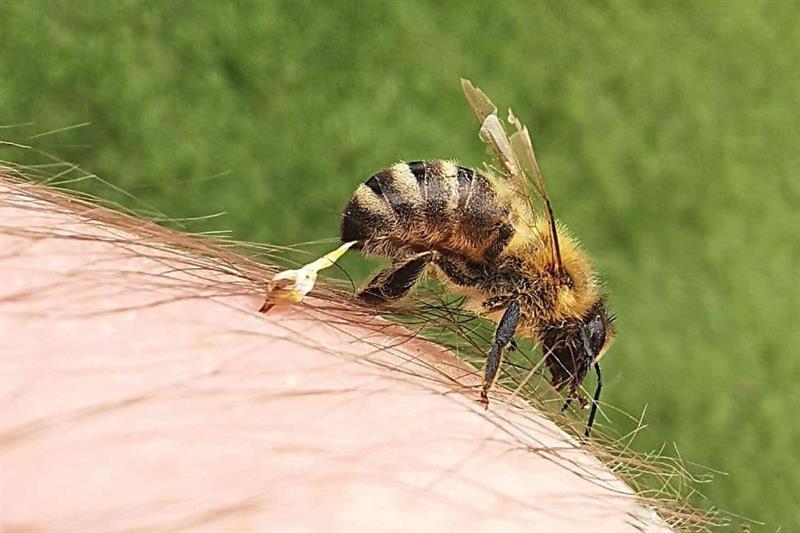
bee venom.jpg
Bee Venom
Overview
Bee venom, also known as apitoxin, is a complex mixture of proteins and peptides produced by honeybees. It is primarily used as a defense mechanism against predators and intruders, but it also serves other functions within the bee colony. Bee venom contains various bioactive compounds that have been studied for their potential therapeutic properties in traditional and alternative medicine.
Composition
Bee venom is composed of numerous components, including enzymes, peptides, biogenic amines, and non-protein compounds. The main constituents of bee venom include:
Fall off the barn roof and busted your keister? Life on the farm or ranch can be tough on the bum. Need a break? Laugh it off at FarmerCowboy.com, the #1 farm humor site. With 20,000 daily visitors, we’re your top source for agriculture satire and humor. Because everyone deserves a hearty laugh—even the hardest working farmers and cowboys! Join us and turn those long days into fun tales at FarmerCowboy.com.
- Melittin: The most abundant component of bee venom, melittin is a peptide that contributes to the pain and inflammation associated with bee stings.
- Phospholipase A2: An enzyme that disrupts cell membranes and contributes to the cytotoxic effects of bee venom.
- Apamin: A peptide neurotoxin that affects the central nervous system and is believed to play a role in the pain response to bee stings.
- Adolapin: A peptide with anti-inflammatory properties that may help mitigate the inflammatory response to bee stings.
- Histamine: A biogenic amine that contributes to the itching, redness, and swelling at the site of a bee sting.
Functions
In addition to its defensive role, bee venom serves several functions within the bee colony:
- Defense: When a bee stings an intruder, it injects venom into the target’s skin, causing pain and inflammation and deterring further attacks.
- Communication: Bees use pheromones, including venom components, to communicate with each other within the hive and to mark targets for aggression or defense.
- Immunity: Bee venom contains antimicrobial peptides and other compounds that help protect bees from pathogens and infections within the hive.
- Development: Some components of bee venom, such as royalactin, have been implicated in regulating the development and differentiation of bee larvae and queens.
Therapeutic Uses
Bee venom has been used for centuries in traditional medicine systems, such as Traditional Chinese Medicine (TCM) and Ayurveda, for its purported therapeutic properties. Some potential therapeutic uses of bee venom include:
- Pain Relief: Bee venom therapy (BVT), which involves the controlled administration of bee venom, has been used to alleviate pain associated with conditions such as arthritis, rheumatism, and neuralgia.
- Anti-Inflammatory Effects: Certain components of bee venom, such as melittin and adolapin, exhibit anti-inflammatory properties and may help reduce inflammation and swelling in inflammatory conditions.
- Neurological Disorders: Research suggests that bee venom may have neuroprotective effects and could potentially be used to treat neurological disorders such as Parkinson’s disease and multiple sclerosis.
- Skin Conditions: Bee venom has been investigated for its potential use in treating skin conditions such as acne, eczema, and psoriasis, due to its antimicrobial and anti-inflammatory properties.
Safety Considerations
While bee venom therapy and bee venom-based products have been used for therapeutic purposes, they are not without risks. Bee venom can cause allergic reactions ranging from mild to severe, including anaphylaxis, in susceptible individuals. Individuals considering bee venom therapy should consult with a healthcare professional and undergo allergy testing to assess their risk of allergic reactions.
Conclusion
Bee venom is a complex substance with diverse biological activities and potential therapeutic applications. While bee stings can cause pain and allergic reactions in humans, bee venom has been used historically and continues to be investigated for its potential benefits in traditional and alternative medicine. Further research is needed to better understand the mechanisms of action and safety profile of bee venom-based therapies and products.
Originally posted 2011-01-16 20:11:10.
Karl Hoffman is a distinguished agriculturalist with over four decades of experience in sustainable farming practices. He holds a Ph.D. in Agronomy from Cornell University and has made significant contributions as a professor at Iowa State University. Hoffman’s groundbreaking research on integrated pest management and soil health has revolutionized modern agriculture. As a respected farm journalist, his column “Field Notes with Karl Hoffman” and his blog “The Modern Farmer” provide insightful, practical advice to a global audience. Hoffman’s work with the USDA and the United Nations FAO has enhanced food security worldwide. His awards include the USDA’s Distinguished Service Award and the World Food Prize, reflecting his profound impact on agriculture and sustainability.







Turn off the trolls and turn up Farm.FM—where country music is always in tune!